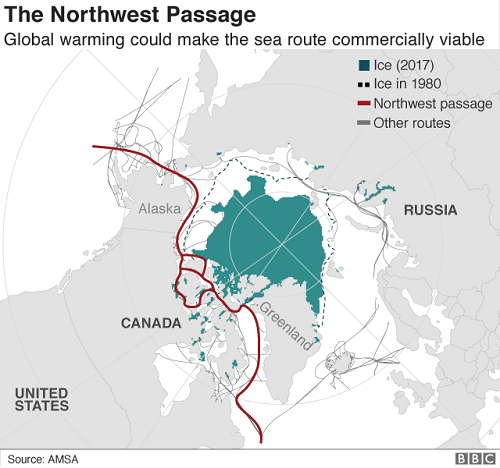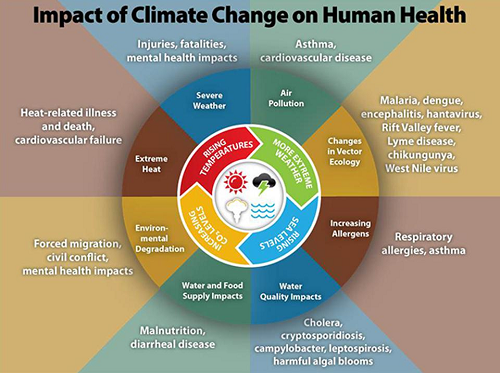What makes planet Earth unique from the countless other planets that orbit around a seemingly infinite array of stars in our universe? Ours is the only known planet that is capable of maintaining an environment supportive of complex life. Through billions of years, this climate has changed and evolved in countless ways. In recent human history, our global climate has stayed relatively consistent and supportive of life as we know it. But the centuries since the dawn of the Industrial Revolution have begun to alter Earth’s climate in dramatic ways. Some impacts, such as global sea level rise are obvious. Others, such as rural water scarcity and desertification can be less noticeable. Though every person on Earth will likely be impacted in some way by climate change, rural communities, especially in the Global South will face the harshest consequences. In this special Earth Day post, let’s examine both the broad global impacts of climate change and some of the local impacts to critically important rural and agricultural communities around the world.
Global Impacts
Climate & Migrations
While the localized impacts of climate change will vary from place to place, the overall effects will be felt in nearly every community around the world. The most obvious of these will be sea level rise. As the temperature warms, glaciers and ice caps become less stable and begin to melt. Most projections for sea level rise predict a likely increase of around half a foot to six and a half feet by the year 2100. Even a modest increase to this extent could directly impact hundreds of millions of people. This includes at least five million Americans whose homes would be completely underwater. After the year 2100, the predictions become more varied, but also potentially more dire. In the most extreme scenarios where the majority of polar ice melts, sea levels could rise by dozens of feet. This would mean entire countries like Bangladesh or the Netherlands would be submerged.
Climate change also tends to worsen extreme weather patterns around the world. Severe weather is likely to become more intense, hurricanes are stronger due to the presence of warmer waters, and dry climates (such as those found throughout the Middle East) can become even drier. With a warmer, drier climate we are more likely to see conflicts over water resources increase in the coming decades. Though advances in desalination could help stave off the worst of these effects in some coastal areas, landlocked parts of South America, Africa, Central Asia, and the Middle East can see much more instability. To make matters worse, wealthier nations will have a difficult time supporting developing nations and maintaining stability to counteract these effects. From an economic perspective, the U.N. estimates that most advanced nations would suffer at least a 1.2 percent loss in GDP from an anticipated two degree centigrade rise in global temperature.
As flooding becomes more severe and wildfires increase in intensity, more and more individuals around the world will be forced to abandon their homes and livelihoods. Many of the most severely impacted will be rural communities in the Global South which often lack the infrastructure needed to mitigate the harmful effects of these severe weather events. Millions will seek shelter in crowded cities as desertification and sea level rise push residents of low-income countries to the brink. The Brookings Institution estimates that roughly 24 million people have been displaced due to climate related catastrophes. The problem continues to worsen year after year. The United Nations High Commissioner for Refugees (UNHCR) believes that nearly 20 million people every year relocate due to increased intensity and frequency of severe weather events. Here again, wealthier and more developed nations will be impacted by this as well, meaning they will have fewer resources with which to support low-income countries with their migration and instability problems.
Global Migration Routes
Global Trade & Petroleum
Climate change is also creating a unique set of geopolitical circumstances in the northern polar trade routes. A decrease in polar ice means that more land and sea lanes will open up around the north pole. Russia and China in particular are in a mad rush to control newly opening sea lanes along the Arctic Ocean. Russia, which has historically always sought a warm water port, will have much more access to ports along its northern shore. China, for its part, can cut the shipping time to markets in Europe by days or even weeks. Canada and Alaska will also benefit from open waterways along their northern shores. If America and Canada cannot capitalize on these new shipping lanes, it will mean a substantial disadvantage for North American businesses and commerce. This could shut out America’s main shipping partners from these markets, leading to higher prices and decreased access to goods for the average American. In an ironic twist, a Russian Liquefied Natural Gas (LNG) tanker recently crossed through the Arctic ocean for the first time during the winter season, demonstrating how quickly these developments will reshape global trade routes.
With the thawing of the Arctic also comes a potential for even more greenhouse gas (GHG) emissions. Petroleum and natural gas serve as the foundation of the Russian economy, making up nearly 36% of Russia’s budget revenues in 2016. As the Arctic ocean becomes increasingly easy to navigate, Russia is eagerly looking to take advantage of the vast undersea oil fields and natural gas reserves near the north pole. In addition, thawing permafrost in areas of Russia, Canada, Alaska, and Greenland threatens to release substantial quantities of buried carbon dioxide, methane, and nitrous oxide into the atmosphere. This would have the effect of creating a devastating feedback loop where more warming releases even more harmful GHG which in turn leads to even more warming.
Local Impacts
Agricultural Shifts
On a local level, climate change will have a dramatic effect on rural communities and agriculture. Widespread flooding in some locations and drought in others due to dried up rivers, lakes, and water tables all provide significant obstacles for staple crop cultivation and livestock production. Rural communities in particular depend on climate-sensitive natural resources and so are at high risk. While farmers in Western nations can typically expect the benefits of nationally backed insurance plans should their crops fail, residents of low-income countries often do not have access to such safety nets. Many farmers are already adjusting to changing climates by planting hardier crops and adjusting planting schedules to compensate for changing weather patters. Unfortunately, these measures are simply not enough to protect most rural communities and small family farms from both the impacts of climate change and the major market forces of large corporate farms. This tension breeds instability and conflict, as seen in the massive ongoing farmer protests in India to protect the agricultural livelihoods of nearly 800 million Indians.
In addition, changes in regional climate can bring about increases in harmful pest populations. Recent research indicates that crop losses from destructive insects could increase up to 25% in the coming years for staple crops like rice, corn, and wheat. But measures to attempt to increase crop yield such as boosting fertilizer use can cause additional pollution problems when heavy rains force excess nitrogen and phosphorus into rural water systems. A similar problem arises with increased usage of antibiotics in livestock. The United Nations Framework Convention on Climate Change (UNFCCC) estimates that around 58% of the 65 major animal diseases impacting agriculture will be sensitive to climate change. As agricultural communities turn to increased antibiotic usage to counteract some of these diseases, it could in turn exacerbate the growing problem of antibiotic resistance in both animal and human populations.
Economic Adjustments
Finally, there are economic impacts of climate change which disproportionately affect rural communities. Hunting, fishing, and forestry jobs are closely tied to the success of many rural areas, particularly in the United States. As regional temperatures change, animal migration patterns adjust and certain high-value species could die out entirely. This is especially concerning in remote areas of states such as Alaska, where indigenous communities depend on hunting to sustain their traditional way of life. Cold weather tourism also faces difficulties. Places that depend upon skiing and ice fishing tourism could be dramatically impacted by warming temperatures and decreased or nonexistent snow packs. While some rural communities may benefit from milder weather, all regions of the country will need to adapt in order to survive and thrive in the face of these changes.
Perhaps the most important of these adaptations will be the need for many rural communities to shift away from depending upon fossil fuels for their income and power generation. Though advances in fracking have increased the availability of some oil and natural gas resources, the overall market trends are beginning to favor renewable resources such as wind and solar. Whether through government regulation or market forces, rural communities whose employment base depends upon these fuels will need to diversify their revenue streams in order to survive. In this way, many rural farmers are finding success in leasing sections of their land for wind and solar power generation. This has the dual benefit of decreasing their dependence upon the fossil fuel industry while also providing the potential for additional revenue from selling their excess power on the market. Entire communities are also beginning to see the financial benefits of transitioning to green energy programs.
In all, the consequences of climate change can be dramatic and varied. These forces are often referred to as “threat multipliers” in national security circles because they take existing problems and amplify their impacts. Still, this existential crisis also provides an opportunity to rethink our approach to a wide range of industries from power generation to global agribusiness. Though we may not be able to stave off the worst impacts of climate change at this point, there is still time to mitigate the most severe risks, transform our most environmentally damaging industries, and give power back to small farmer communities in the process. With any luck, we can continue to make Earth the unique, life-sustaining planet that stands out amongst all others in the cosmos.





